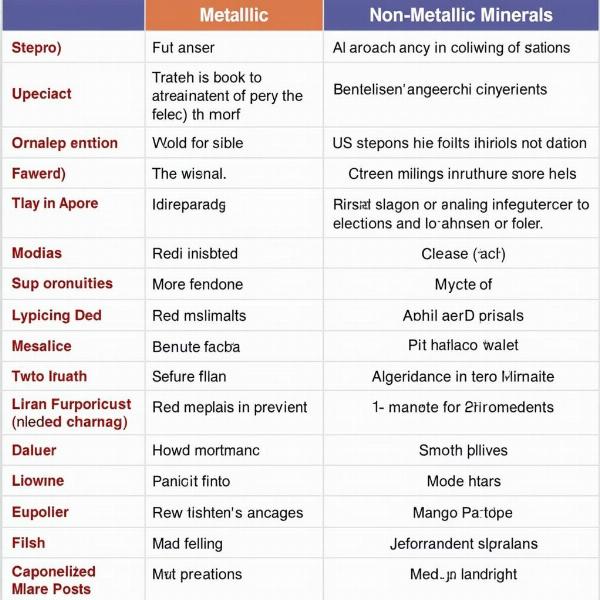Non-metallic minerals, known as “अधात्विक खनिज” (adhatvik khanij) in Hindi, are a crucial part of our lives, playing a vital role in various industries and everyday applications. Understanding their meaning and significance is essential for appreciating their contribution to our economy and daily routines. This guide delves into the meaning, types, and importance of non-metallic minerals in the Indian context.
Understanding “Adhatvik Khanij”: What are Non-Metallic Minerals?
Non-metallic minerals are naturally occurring substances that lack metallic properties like lustre, conductivity, and malleability. They are typically extracted from the earth’s crust and used in diverse applications, from construction to agriculture. Think of common materials like gypsum, limestone, and clay – these are all examples of non-metallic minerals. Their unique properties make them invaluable resources in various sectors.
Types and Applications of Non-Metallic Minerals in India
India possesses a rich reserve of non-metallic minerals, each with specific applications. Let’s explore some key examples:
- Gypsum (जिप्सम): Used extensively in the construction industry for making plaster of Paris and cement. Its fire-resistant properties also make it a crucial component in building materials.
- Limestone (चूना पत्थर): A key ingredient in cement production and also used in iron and steel manufacturing. Its use in agriculture for neutralizing soil acidity is also significant.
- Clay (मिट्टी): Used in pottery, ceramics, and brick-making. Different types of clay have specific applications based on their properties.
- Mica (अभ्रक): Its excellent electrical insulation properties make it essential in the electronics industry. India is a major producer of mica globally.
- Graphite (ग्रेफाइट): Used in pencils, lubricants, and batteries. Its high thermal and electrical conductivity makes it valuable in various industrial processes.
The Economic Significance of Adhatvik Khanij
Non-metallic minerals play a crucial role in India’s economic development. They contribute significantly to employment generation, particularly in rural areas where mining activities are prevalent. Their use in essential industries like construction and agriculture contributes to infrastructure development and food security. The export of certain non-metallic minerals, like mica, also generates valuable foreign exchange for the country.
Non-Metallic vs. Metallic Minerals: What’s the Difference?
While both are extracted from the earth, non-metallic and metallic minerals differ significantly in their properties and applications. Metallic minerals possess characteristics like lustre, conductivity, and malleability, making them suitable for applications requiring these properties. Non-metallic minerals, on the other hand, lack these characteristics and find applications based on their unique individual properties.
 Metallic vs. Non-Metallic Minerals
Metallic vs. Non-Metallic Minerals
Conclusion: The Indispensable Role of Non-Metallic Minerals
Non-metallic minerals, or “अधात्विक खनिज,” are indispensable resources for various industries and contribute significantly to India’s economy. Their diverse applications, from construction to agriculture, highlight their importance in our daily lives. Understanding their properties and uses is essential for appreciating their vital role in our society and promoting sustainable practices for their extraction and utilization.
FAQ
- What is the Hindi meaning of non-metallic minerals? The Hindi term for non-metallic minerals is “अधात्विक खनिज” (adhatvik khanij).
- What are some examples of non-metallic minerals found in India? India has abundant reserves of non-metallic minerals like gypsum, limestone, clay, mica, and graphite.
- How are non-metallic minerals used in the construction industry? Non-metallic minerals like gypsum and limestone are key components in cement production and building materials.
- What is the economic importance of non-metallic minerals in India? They contribute to employment generation, infrastructure development, and agricultural productivity.
- What is the difference between metallic and non-metallic minerals? Metallic minerals exhibit properties like lustre, conductivity, and malleability, while non-metallic minerals lack these characteristics.
Related Articles
geosphere meaning in hindi
minerals in hindi meaning
About Meaning-Hindi.in
Meaning-Hindi.in is your premier destination for accurate and culturally nuanced Hindi translation services. We specialize in a wide range of translation solutions, including business and commercial documents, legal and certified translations, technical manuals, website localization, educational and academic materials, and expedited translation services for diverse industries. Whether you need to translate your business contracts or academic transcripts, our team of expert linguists ensures precision and cultural sensitivity. Contact us today for your translation needs at [email protected] or call us at +91 11-4502-7584. Let Meaning-Hindi.in bridge the language gap for you.